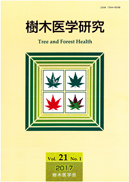Volume 13, Issue 1
Displaying 1-7 of 7 articles from this issue
- |<
- <
- 1
- >
- >|
Obituary
-
2009 Volume 13 Issue 1 Pages 1-
Published: January 31, 2009
Released on J-STAGE: March 15, 2021
Download PDF (285K)
Articles
-
2009 Volume 13 Issue 1 Pages 3-11
Published: January 31, 2009
Released on J-STAGE: October 27, 2020
Download PDF (1267K) -
2009 Volume 13 Issue 1 Pages 12-16
Published: January 31, 2009
Released on J-STAGE: October 27, 2020
Download PDF (606K)
Short Communication
-
2009 Volume 13 Issue 1 Pages 17-20
Published: January 31, 2009
Released on J-STAGE: October 27, 2020
Download PDF (462K)
Introduction to Tree and Forest Health
-
2009 Volume 13 Issue 1 Pages 21-27
Published: January 31, 2009
Released on J-STAGE: March 15, 2021
Download PDF (988K)
Natural Monument Trees in Japan
-
2009 Volume 13 Issue 1 Pages 28-31
Published: January 31, 2009
Released on J-STAGE: March 15, 2021
Download PDF (1376K)
Members’ Plaza
-
2009 Volume 13 Issue 1 Pages 32-33
Published: January 31, 2009
Released on J-STAGE: March 15, 2021
Download PDF (918K)
- |<
- <
- 1
- >
- >|
